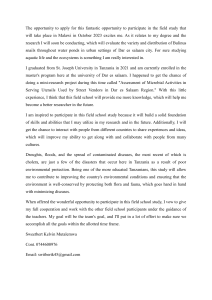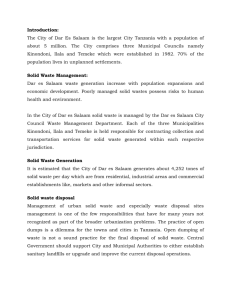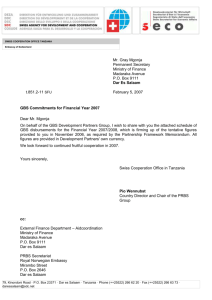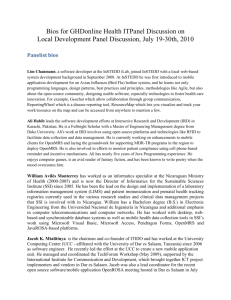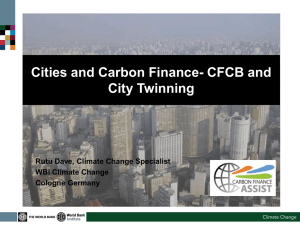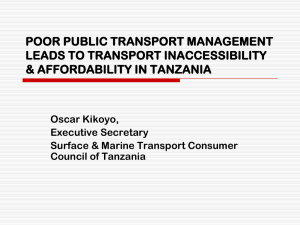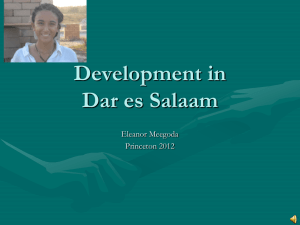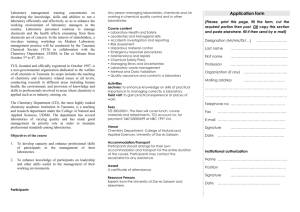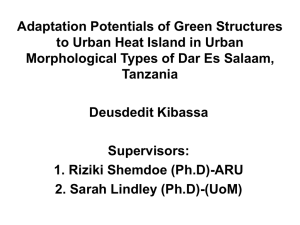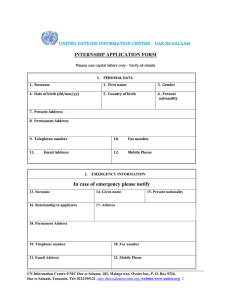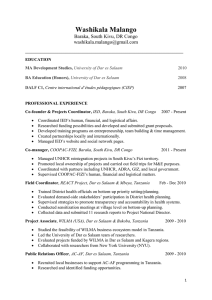New urbanities - L'Africa delle città | Urban Africa
advertisement
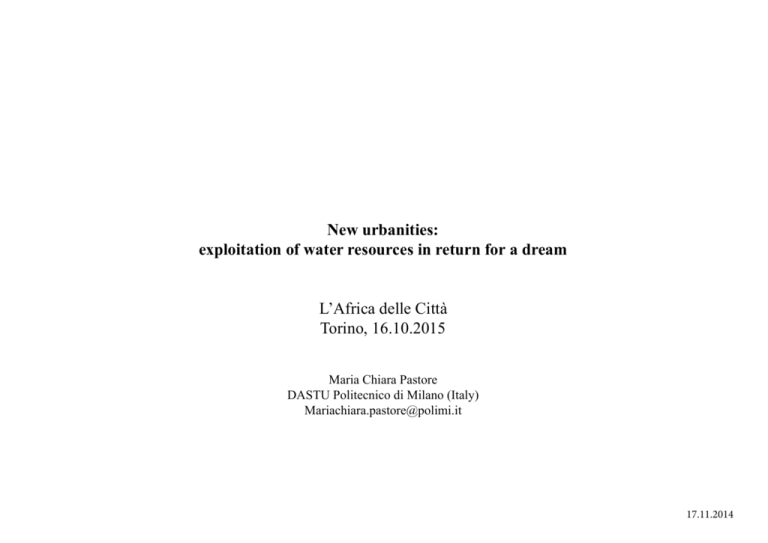
New urbanities: exploitation of water resources in return for a dream L’Africa delle Città Torino, 16.10.2015 Maria Chiara Pastore DASTU Politecnico di Milano (Italy) Mariachiara.pastore@polimi.it 17.11.2014 New urban plans are popping up all over Sub-Saharan African cities. Private firms and consortia are all involved in the preparation of future plans and images of these cities. These images represent stunning, supermodern, highrise glass buildings appearing in green and neat streets, mesmerizing seductive words to investors and politicians. These projects include both new areas of development, usually placed in proximity of the primate cities, or they strategically define the new city schemes: satellite centres, new centralities. King City, TAKORADI Eko Atlantic, LAGOS Konza Techno City Tatu City, NAIROBI Oyala/Dijibloho, MALABO La Cité du Fleuve KINSHASA Kigamboni New City DAR ES SALAAM These plans do not ponder the reality of these cities, inhabited in large part by low-income earners that occupy informally the city lands, in deficit of the basic infrastructure. Rapid population growth impacts on the existing infrastructure, overstretched and exploited, with poor government capacity and with small funds to count on in order to invest in new infrastructure; In the meantime the city is expanding and relying on unconnected informal networks. The case Study: Dar es Salaam The city is divided administratively into three districts: Kinondoni, Ilala and Temeke. Each municipality is divided into wards and sub-wards and works as a semi-autonomous authority, reporting directly to the Prime Minister’s Office – Regional Administration and Local Government (PMO-RALG). The municipalities are in charge of the provision of basic services, primary health care, waste management, water supply, local roads and urban planning. Water and sanitation are managed by DAWASA, a public owned company responsible for water and sewage provision, while DAWASCO, a parastatal company is in charge of the operations. The capacity of the water distribution system is able to serve 58% of the inhabitants. 22% of the population is reached by a piped system 41% of inhabitants are reached by water services (directly and indirectly). Water comes from pipes (water is extracted by rivers, piped to reservoirs and distributed through mains), boreholes, wells, kiosks, tanks, push carts, rain water harvesting. Water distribution system Year 2010 Water sources in Dar es Salaam and service through the city ward level Year 2010 State of water supply services Year 2010 Dar es Salaam is a primate city of 4,364,541 inhabitants, with a growth rate of 5.6%. Settlement distribution Planned/Unplanned Areas Year 2010 Population density year 2002 (person per ha; quintile division) Water demand projection year 2007 (m3/day) Water Demand projection year 2032 (m3/day) In respect to sanitation, 3.7% of the total households is served by piped sewage; 7% is served by septic tanks 90% uses on site systems Sewerage is collected by sewers (only in the city centre) and directly discharged into the sea, by 9 oxidation ponds, distributed in the most dense built areas, and by on-site systems as latrines. Waste-water treatment plants, flooding areas and main river system Year 2010 Dar es Salaam The project, “Kigamboni New City”, sponsored directly by the MLHHSD, intends to accommodate 500,000 people , with development of high-income targeted housing, and new facilities. It includes a new CBD, with a new government pole, the strengthening of touristic activities, and exploitation of the residential sector (with typologies as apartment housing, resort houses, detached houses). The area actually hosts 82.808 people , and households account for 13.883. Calculation upon the actual population and population growth projections have been justified the 500.000 people in 2030, with the increase in household per 83.400 new buildings Kigamboni Kigamboni Kigamboni Kigamboni Kigamboni Kigamboni Kigamboni In order to sustain the feasibility of the project, the area will benefit from the provision of a new groundwater resources (Kimbiji and Mpera sites for water extraction), prioritized by DAWASA that will serve the new settlements. Water demand has been calculated on the basis of actual water demand by high income households in Tanzania (250 litres per person per day), on the percentage of loss estimated on 20-25% (in Tanzania in 2010, reports account for 52%), and on overseas examples (Yemen, Oman, Algeria, Korea), with a total demand per day of 181,500 m3/day, more than the water effectively supplied every day in DAWASA’s service area, that is 164,000 m3/day. Two treatment plants are planned in order to treat a daily sewage of 140,000 m3/day (including industrial wastewater). About 38,000 m3/day of sewage is collected and treated through these systems, while daily production is estimated to be more than 255,000 m3/day. It is also estimated that 10-14% of total liquid waste water is treated by the waste stabilization ponds, while the rest is either buried underground or discharged directly into rivers and streams. The other issue regards the governance: the size of the project seems to justify the proposal of a new authority over the project area; proposals include the birth of a new institution (Kigamboni New City Development Authority), which seems basically a new Municipality (apparently under the authority of The PMO-RALG, as Ilala, Temeke, and Kinondoni). DAWASA is (two sewage extraction in while KDA distribution, reservoirs in charge of the plants treatments, and the water Mpera and Kimbiji sites), is responsible for water sewerage network and Concluding remarks Urban areas represent the first places in which water services are implemented and need to be pilot areas for the upcoming urbanity of the next decades. Considering that the city can be served by both on-site and offsite sanitation systems, in a more structured way, and linking the most appropriate technologies to the actual and future conditions of the settlements, it is possible to imagine the future development by avoiding segregation due to the unequal distribution of the infrastructure and adapt cities to safer water and sanitation system that would avoid major health disasters. The scale of the new projects, such as Kigamboni, even if only partially realized, might impinge the future of water and sanitation resources in different sectors. Difference in water demand, and water use are for example mainly affected by these projects. The quantity of water allocated to these areas might create water shortages in other parts of the city, widening the water stress and increasing prices. The scale of these projects, more like cities within cities, will realistically enhance the social division, with areas of the city served by all the kind of urban services and other parts left without services or maintenance. Even the governance of these projects, moving towards private management will negatively impact on the whole city, increasing the challenges of the future equitable development of the urban areas. Possibly, local municipalities, and citizens, not only directly involved by the project itself, but because of the importance of the project for the entire city, can develop strategies of participation in order to evaluate the final outcome for the city. Concluding Remarks Thank You
